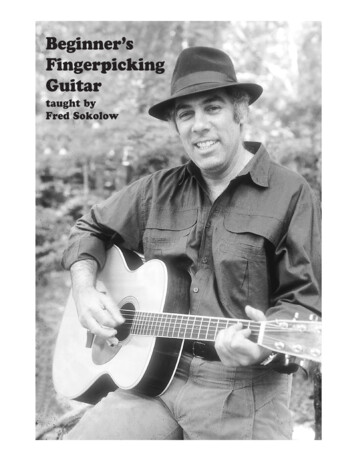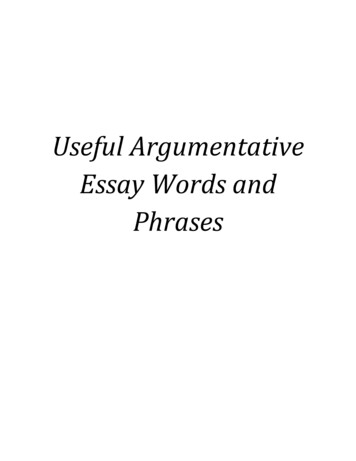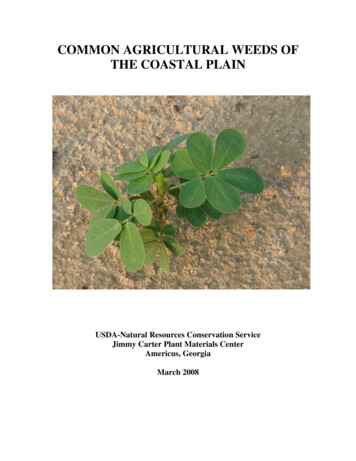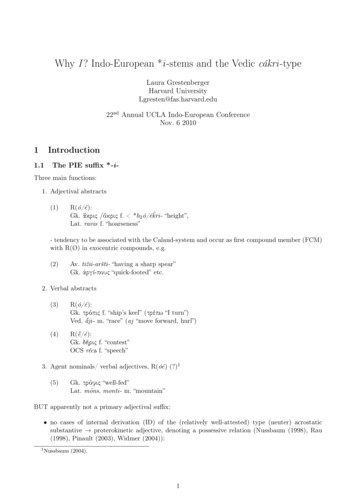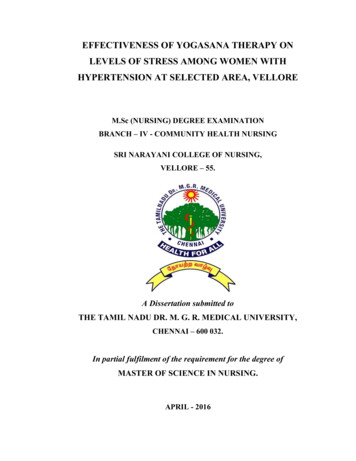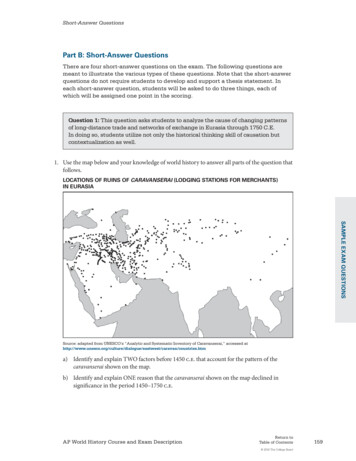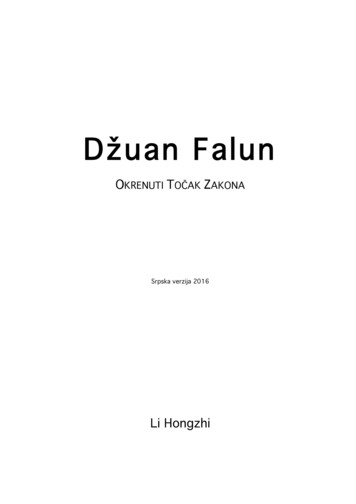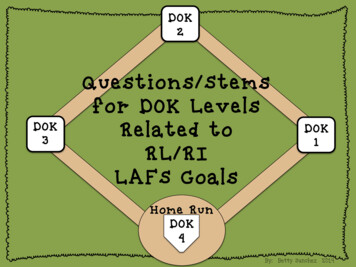
Transcription
DOK2DOK3Questions/Stemsfor DOK LevelsRelated toRL/RILAFS GoalsDOK1Home RunDOK4By: Betty Sanchez 2014
DOK Level 1-4 Questions/Stemsfor Each of the LAFS RL/RI Learning Goals Each page has appropriate questions that have already been developed for each ofthe Learning Goals. The questions can be applied to any and ALL stories or textsthat are shared in your classroom. In the left margin of each page, the LAFS RL/RI learning goals have been labeledwith the DOK levels. The goals are color-coded which correlate to the coloredcolumns on the chart. This color-coded column indicates the DOK Level which isdenoted as the required standard of mastery for that goal. Scaffolding is a CRUCIAL part of the goals therefore questions from each of thelevels can be applied to build a solid foundation to reach mastery of the standard.Also, reaching up and beyond to challenge our students to extend their thinking byutilizing questions from the higher DOK levels proves beneficial! The red words, terms or phrases that are in parenthesis within the questions/stems should be inputted by the teacher based on the chosen text. EX: Using the(text feature), locate the facts about ----?lifecycle diagram Simply print these handy, ready-to-use questions to assist you during reading timeand your students will be hitting HOME RUNS!By: Betty Sanchez 2014
DOK QUESTIONS/STEMS FORLAFS RL LEARNINGGOALSBy: Betty Sanchez 2014
543LAFS.K.RL.1.1 With prompting and support, ask and answer questions about key details in a text. DOK 2LAFS.1.RL.1.1 Ask and answer questions about key details in a text. DOK 2LAFS.2.RL.1.1 Ask and answer such questions as who, what, where, when, why, and how to demonstrate understanding ofkey details in a text. DOK 2LAFS.3.RL.1.1 Ask and answer questions to demonstrate understanding of a text, referring explicitly to the text as the basis forthe answers. DOK 2LAFS.4.RL.1.1 Refer to details and examples in a text when explaining what the text says explicitly and when drawing inferencesfrom the text. DOK 2LAFS.5.RL.1.1 Quote accurately from a text when explaining what the text says explicitly and when drawing inferences from thetext. DOK 2K11DOK Level Question Stems related to Learning Goals:1.1LRDOK 1DOK 2DOK 3DOK 4Who are thecharacters in (thisstory)?Can you explain why(that event)happened in thestory?Can you predictwhat would havehappened if ------?If ------ would havehappened, how wouldthe ending of thestory change?Where does (thisstory) take place?Can you predictwhat willhappen next?Using words fromthe story, can youexplain why (thecharacter) did that?How were the eventsof (this story) thesame as the eventsof (those stories)?What Is theproblem in(the story)?How would youcompare/contrast(this event) to the(that event)?Do you think that theway the authordescribes (thecharacter) makes thereader think he/sheis -------? Why?Do you agree/disagreewith the author’schoice of (this story’s)outcome? Why?How are(these 2 characters)alike/different?Do you know anothertime whenhappened in a story?What questions couldyou ask to support adifferentperspective?How would yousummarize (thisstory)?What question couldyou ask (the maincharacter) about(the problem)?What are theeventsin (the story)?What isthe solution?What can be learnedabout (thecharacter’s) actionsthat can help you inyour life?By: Betty Sanchez 2014
DOK 1DOK 2DOK 3DOK 4Who are thecharacters in(this story)?Can you retellthe problem in yourown words?Can you predictwhat would havehappened if.?Explain why you thinkthat there aredifferent versionsof (this folktale).What happened inthe beginning of(this story)?Can you retellthe first event inyour own words?Why do you thinkthe author chose notto solve the problemwith (restate event)?How would youimprove upon (thischaracter’s) actions asrelated to the theme?Justify reasons.What happened inthe middle of(this story)?Can you retellanother event inyour own words?What is yourinterpretation of thetheme of (this story)?Justify your thoughts.What can be learnedabout readingmultiple stories with-------- theme?What happenedat the end of(this story)?Can you retellthe solution in yourown words?Can you makeconnections between(the main character’s)actions and thestory’s message?Do youagree/disagree with(the character)?Justify yourreason(s).What does the wordsolution mean?Can you tell(this story’s)lesson in your ownwords?Could this storyhappen in(new time or place)?Why or why not?Can you think of away to deal withsomeone who actslike (the character)?"""453LAFS.K.RL.1.2 With prompting and support, retell familiar stories, including key details. DOK 2LAFS.1.RL.1.2 Retell stories, including key details, and demonstrate understanding of their central message or lesson. DOK 2LAFS.2.RL.1.2 Recount stories, including fables and folktales from diverse cultures, and determine their central message,lesson, or moral. DOK 3LAFS.3.RL.1.2 Recount stories, including fables, folktales, and myths from diverse cultures; determine the central message,lesson, or moral and explain how it is conveyed through key details in the text. DOK 2LAFS.4.RL.1.2 Determine a theme of a story, drama, or poem from details in the text; summarize the text. DOK 3LAFS.5.RL.1.2 Determine a theme of a story, drama, or poem from details in the text, including how characters in a storyor drama respond to challenges or how the speaker in a poem reflects upon a topic; summarize the text. DOK 3 ""K12DOK Level Question Stems related to Learning Goals:2.1LRBy: Betty Sanchez 2014
DOK 1DOK 2DOK 3DOK 4Do youagree/disagree withthe actions of(the main character)?Why?Who is the maincharacter in thestory?Describe the settingof the story in yourown words.How does the authorcreate the sense of(tension, happiness,etc) in the story?Where does thisstory take place?Tell me somegood/bad traits ofthe main character.How would you solve(this problem) usingwhat you havelearned about(the character)?What judgment(s)wouldyou make about theactions of(the main character)?What is the problemin the story?Explain why theproblem exists in thestory.Why do you think theauthor chose to solvethe problem by(restate solution)?If you were(the main character),what choice wouldyou have made about(the event)? Why?Tell me one way theytried to solve theproblem but it didn’twork.Describe how themain characterreacts to thesolution.What is therelationship betweenthe (main character)and the way theproblem was solved?If you could change themain character, whowould you choose andhow would that impactthe story?Does this story showany kind of pattern?If so, what is it?Can you explain whythe solution workedand the other eventsdid not solve theproblem?If you were theauthor, how wouldyou improve theplot? Why wouldthat make it better?""""What is the solution?"54LAFS.K.RL.1.3 With prompting and support, identify characters, settings, and major events in a story. DOK 1LAFS.1.RL.1.3 Describe characters, settings, and major events in a story, using key details."""DOK 2LAFS.2.RL.1.3 Describe how characters in a story respond to major events and challenges. DOK 2LAFS.3.RL.1.3 Describe characters in a story (e.g., their traits, motivations, or feelings) and explain how their actionscontribute to the sequence of events. DOK 2LAFS.4.RL.1.3 Describe in depth a character, setting, or event in a story or drama, drawing on specific details in the text(e.g., a character’s thoughts, words, or actions). DOK 2LAFS.5.RL.1.3 Compare and contrast two or more characters, settings, or events in a story or drama, drawing on specificdetails in the text (e.g., how characters interact). DOK 2""K123DOK Level Question Stems related to Learning Goals:3.1LRBy: Betty Sanchez 2014
DOK 1DOK 2DOK 3DOK 4Can you write/drawin your own waywhat you think(the word) means?What story evidencecan you find to letyou know that(the word)means ---?What word or phrasechoices would you havemade to describe(the character’s)actions?Do you know whatthat word means?How does (thisword) make you feel?Why do you thinkthe author chose(the word or phrase)to describe ----?Can you create anew story part usingthe same phrasingthat the authorchose?Are there any wordsthat you would liketo ask a questionabout?How do you knowthat (the word)means ?What is the relationshipbetween (the word orphrase) and thecharacter’s actions?Which use of the phrase,-------, is BEST used toshow its meaning? Developa persuasive argument toprove your point.How would youdefine (word)?How would yourephrase the meaningof (the word)?How are (the wordsor phrasing) relatedto the theme of thestory?Can you compare otherstories that use thesame type of phrasing tosee if it has the sameuse or meaning?Do you know anyletters/sounds thathelp you read(the word)?Can youidentify the wordsthat make you feel---- ?Can you explain whythe author chose towrite the story inthis format?Explain how you feelwhen you compare thephrasings from (2-3different stories) fromthis author.Do you know whatthat word says?543LAFS.K.RL.2.4 With prompting and support, ask and answer questions about unknown words in a text. DOK 2LAFS.1.RL.2.4 Identify words and phrases in stories or poems that suggest feelings or appeal to the senses. DOK 2LAFS.2.RL.2.4 Describe how words and phrases (e.g., regular beats, alliteration, rhymes, repeated lines) supply rhythmand meaning in a story, poem, or song. DOK 2LAFS.3.RL.2.4 Determine the meaning of words and phrases as they are used in a text, distinguishing literal from nonliterallanguage. DOK 2LAFS.4.RL.2.4 Determine the meaning of words and phrases as they are used in a text, including those that allude to significantcharacters found I n mythology (e.g., Herculean). DOK 2LAFS.5.RL.2.4 Determine the meaning of words and phrases as they are used in a text, including figurative language such asmetaphors and similes. DOK 2""""K12DOK Level Question Stems related to Learning Goals:RL 2.4By: Betty Sanchez 2014
DOK 1DOK 2DOK 3DOK 4What are the namesof the differentkinds of texts?Can you provide anexample of anon-fiction textfeature?Explain why youcategorized thestories in that way.Can you assess thevalue of this stanza,nonfiction text feature,chapter, etc. to thispoem, informationaltext, etc ?What doesnon-fiction mean?How can you showyour understandingof the structure ofa story?Can you compare theuse of (non-fictiontext feature) onp. ---- to the oneon p. -----?What conclusions canyou make that justifywhy (this author)chooses to write using(this structure)?What doesfiction mean?How would youclassify this text?After looking at all of(these non-fictional textfeatures), explain howthey are helpful whenlearning?What type of text wouldbe the best choice forthe reader to interpret(this information)?Justify your choice.Is this a poemor play?Compare/contrastthe structures offictions andnon-fiction texts.Can you explain whyan author follows astory map whenwriting fictionalstories?Evaluate why the seriesof stanzas or chapters,etc fit together tocreate a structure inthis poem, novel, etc .What characteristicsmake thisstory a -----?Can you explain whythe author chose towrite (the story/text)in this way?"""Name the partsof afictional story.""54LAFS.3.RL.2.5 Refer to parts of stories, dramas, and poems when writing or speaking about a text, using terms such aschapter, scene, and stanza; describe how each successive part builds on earlier sections. DOK 2 .K.RL.2.5 Recognize common types of texts (e.g., storybooks, poems). DOK 1LAFS.1.RL.2.5 Explain major differences between books that tell stories and books that give information,drawing on a wide reading of a range of text types. DOK 2LAFS.2.RL.2.5 Describe the overall structure of a story, including describing how the beginning introduces thestory and the ending concludes the action. DOK 2K1DOK Level Question Stems related to Learning Goals:5.2LREvaluate why it isimportant to readmany kinds of texts.Justify your answer.By: Betty Sanchez 2014
DOK 1""DOK Level Question Stems related to Learning Goals:""K""""LAFS.K.RL.2.6 With prompting and support, identify the author and illustrator of a story and define the role ofeach in telling the story. DOK 11 LAFS.1.RL.2.6 Identify who is telling the story at various points in a text." DOK 22 LAFS.2.RL.2.6 Acknowledge differences in the points of view of characters, including by speaking in a differentvoice for each character when reading dialogue aloud. DOK 23""""LAFS.3.RL.2.6" he"narrator"or"those"of"the"characters."DOK""3"4 LAFS.4.RL.2.6" ons."DOK"3"5 LAFS.5.RL.2.6 Describe how a narrator’s or speaker’s point of view influences how events are described. DOK 2 ""6.2LRDOK 2DOK 3DOK 4What is the nameof the author ofthis story?Can you provide anexample of whatthe illustrator doesin this story?Explain thedifferences in theauthors’ points ofview in these stories?What changes wouldyou recommend tothe illustrator?Why?What is the name ofthe illustrator ofthis story?Explain thedifferences betweenthe author and theillustrator’s jobs?Using text evidence, howdo you know that(character’s andauthor’s) points of vieware same/different?What changes wouldyou recommend tothe author?Why?What does anauthor do?Identify who is tellingthe story at(this part). Explainhow you know.Using text evidence, howdo you know that(character) feelsdifferently than(character)?How would you ratethe illustrator’s job?Why?What does anillustrator do?Why did I change myvoice when I read(this part) in thestory?Describe how youwould judgethe opinions of(these characters)?Using (these texts)prove which job(author or illustrator)was MORE important.Who writes thewords in the story?How do you knowthat (the characters)acted or feltdifferently?How is the author’sjob similar to that ofthe illustrator’s job?Explain with textevidence.Is the author’s job orthe illustrator’s jobMORE important in thistext? Use evidence toargue your point.By: Betty Sanchez 2014
DOK 1DOK 2DOK 3DOK 4Which illustration inthe story shows------?Describe how (thisillustration) showswhat the story issaying.What conclusions canyou make from thecomparisons of thephotos on p. ---- andp. -----?What judgment wouldyou make about theillustrator’s choiceof pictures? Why?Locate theillustration thatshows the setting ofthe story.Describe how (thisillustration) showsthat (the character)is -----.Can you tell thedifference in the waythe illustrator drewthe picture on p. -and the one on p. --?What changes wouldyou tell the illustratorto do to create adifferent mood? Howwill that work?Which illustrationshows(the main character)?Describe how(this illustration)is creating thestory’s mood.Why do you think theillustrator chose to put------- in the picture onp. ----? Use textevidence to prove it.Suppose you coulddraw an illustration forthe text on p. ---.What would it showand why?Which illustrationshows that(the character)feels ------?Can you show anexample of how theillustrator is showingthe mood of ------?What text evidencecan you find thatwould prove that theillustrator’s picture isdrawn correctly?How would you improvethe visual on p. --- tobetter show theauthor’s ideas?Which illustrationmatches(these words)?What can you sayabout the way theillustrator drew thispicture?What conclusions canyou make from theillustrator’s choice ofpictures?What information canyou gather from thevisuals to supportyour idea about----?54312LAFS.K.RL.3.7 With prompting and support, describe the relationship between illustrations and the story in which theyappear (e.g., what moment in a story an illustration depicts)."DOK 2LAFS.1.RL.3.7 Use illustrations and details in a story to describe its characters, setting, or events. DOK 2LAFS.2.RL.3.7 Use information gained from the illustrations and words in a print or digital text to demonstrateunderstanding of its characters, setting, or plot. "DOK 2LAFS.3.RL.3.7 Explain how specific aspects of a text’s illustrations contribute to what is conveyed by the words in a story(e.g., create mood, emphasize aspects of a character or setting). DOK 2LAFS.4.RL.3.7 Make connections between the text of a story or drama and a visual or oral presentation of the text,identifying where each version reflects specific descriptions and directions in the text. DOK 2LAFS.5.RL.3.7 Analyze how visual and multimedia elements contribute to the meaning, tone, or beauty of a text (e.g., graphicnovel, multimedia presentation of fiction, folktale, myth, poem). DOK 3 "KDOK Level Question Stems related to Learning Goals:7.3LRBy: Betty Sanchez 2014
A Learning Goal forRL 8 does not exist.
DOK 1DOK 2DOK 3DOK 4Describe how (themain character)reacts to his/heradventure.Explain why theauthor chooses(these characters)for this theme?Which version of(title) do you think isbetter? Why?Does the character in(the story) have agood or badadventure?Which is the MOSTimportant characterin the story?What evidence can youfind in both storiesthat proves the themerelates to the patternof events?Suppose you were themain character in (title),would you act the sameor different from(character) in (title)?Why or why not?Tell what the maincharacter looks like.What are thedifferences between(the characters) inthe story?How are the adventuresof (the characters) thesame in both (of thesestories)?How would you changethe adventures of(character) in (title) toimprove the version?Where does theadventure takeplace?What can yousay about(the character)?Are the actions of(the character) and(the other story’scharacter) the sameor different? How?Evaluate why you thinkthat (this story) hasmore than one version?What is the maincharacter’sadventure?Compare/contrastthe approaches tothe themes of thesestories?How are the versionsof (title) similar anddifferent?Can you think of anew version for thisstory?What is the name ofthe main character in(the story)?"DOK Level Question Stems related to Learning Goals:"K LAFS.K.RL.3.9 With prompting and support, compare and contrast the adventures and experiences of characters infamiliar stories. DOK 31LAFS.1.RL.3.9 Compare and contrast the adventures and experiences of characters in stories. DOK 32 LAFS.2.RL.3.9 Compare and contrast two or more versions of the same story (e.g., Cinderella stories) by differentauthors or from different cultures. "DOK 33LAFS.3.RL.3.9 Compare and contrast the themes, settings, and plots of stories written by the same author about thesame or similar characters (e.g., in books from a series). DOK 34LAFS.4.RL.3.9 Compare and contrast the treatment of similar themes and topics (e.g., opposition of good and evil) andpatterns of events (e.g., the quest) in stories, myths, and traditional literature from different cultures. DOK 3""5 LAFS.5.RL.3.9 Compare and contrast stories in the same genre (e.g., mysteries and adventure stories) on theirapproaches to similar themes and topics. DOK 2 ""9.3LRBy: Betty Sanchez 2014
DOK Level Questionswere not created forRL 10.
DOK QUESTIONS FORLAFS RILEARNING GOALS
DOK 1DOK 2DOK 3DOK 4When did(event)happen?Can you explain why(this fact) isimportant in thetext?What is the MOSTimportant part of theinformation about-----? Use textevidence to tell why.Explain yourconnection to theinformation in thistext.Where is------?What newinformation did youlearn about -----?Which is the BESTanswer for (thisquestion) about ----?Use text examples toexplain.How were the facts in(this text) moreimportant then thefacts in (these texts)?Explain why.Name a factabout ------.When we/you weredone reading, whatwere our/yourquestions that wereleft unanswered?Can you ask anoriginal questionabout this fact?What can you infer fromthe information yougathered from the factsin these texts? Usequotes from the text inyour explanation.How are(these two facts)alike/different?Can you make aconnection from (thisinformation) tosomething else?How can you judge theimportance ofunderstanding (thedetailed information)?Can you explain how(this fact) helps youunderstandthe information?What facts wouldyou select tosupport youranswer?Design/make a modelof ------ to proveyour understandingof the details.What kind of-------is --------?Who isfamous for------?543LAFS.K.RI.1.1 With prompting and support, ask and answer questions about key details in a text. DOK 2LAFS.1.RI.1.1 Ask and answer questions about key details in a text. DOK 2LAFS.2.RI.1.1 Ask and answer such questions as who, what, where, when, why, and how to demonstrateunderstanding of key details in a text. DOK 2LAFS.3.RI.1.1 Ask and answer questions to demonstrate understanding of a text, referring explicitly to the textas the basis for the answers. DOK 2LAFS.4.RI.1.1 Refer to details and examples in a text when explaining what the text says explicitly and whendrawing inferences from the text. DOK 2LAFS.5.RI.1.1 Quote accurately from a text when explaining what the text says explicitly and when drawinginferences from the text. DOK 2 ""K12DOK Level Question Stems related to Learning Goals:1.1IRBy: Betty Sanchez 2014
DOK 1DOK 2DOK 3DOK 4What is amain idea?Determine thedetails that supportthe main idea.Explain why the authorwould choose to use(these details) asa way tosupport the main idea.Explain a connection tothe details in(this text) to somethingyou have learned aboutin another subject.What doeskey detailmean?Compare(the details)given about themain idea.Which of(these details)proves a betterway to explain themain idea? Why?Explain how thisauthor’s use of the(key details) were morehelpful than (thisauthor’s) in (this text).What is atopic?Contrast(the details)given about themain idea.How are (these details)related to the mainidea. Use textevidence to supportyour ideas.Why do you thinkthat (these facts)were the best wayto share thisinformation?Which sentenceBEST tells themain idea?How could you adaptthe details to developa new main idea?Which of the author’stexts do you thinkhelped you the most?Why?Can you sort thesedetails that do anddo not support themain idea?How would you describethe order that the factswere written in this textas they are related tothe main idea?What details can yougather to supportyour own idea?Can you locate onedetail in the text?Can you identifya detail on thischart/graph?"543LAFS.K.RI.1.2 With prompting and support, identify the main topic and retell key details of a text. DOK 2LAFS.1.RI.1.2 Identify the main topic and retell key details of a text."DOK 2LAFS.2.RI.1.2 Identify the main topic of a multi-paragraph text as well as the focus of specific paragraphswithin the text. DOK 2LAFS.3.RI.1.2 Determine the main idea of a text; recount the key details and explain how they support themain idea. DOK 2LAFS.4.RI.1.2 Determine the main idea of a text and explain how it is supported by key details; summarize thetext. DOK 2LAFS.5.RI.1.2 Determine two or more main ideas of a text and explain how they are supported by keydetails; summarize the text. DOK 2""K12DOK Level Question Stems related to Learning Goals:2.1IRBy: Betty Sanchez 2014
54312LAFS.K.RI.1.3 With prompting and support, describe the connection between two individuals, events, ideas, or pieces ofinformation in a text."DOK 3LAFS.1.RI.1.3 Describe the connection between two individuals, events, ideas, or pieces of information in a text. DOK 3LAFS.2.RI.1.3 Describe the connection between a series of historical events, scientific ideas or concepts, or steps in technicalprocedures in a text. DOK 3LAFS.3.RI.1.3 Describe the relationship between a series of historical events, scientific ideas or concepts, or steps intechnical procedures in a text, using language that pertains to time, sequence, and cause/effect. DOK 3"LAFS.4.RI.1.3 Explain events, procedures, ideas, or concepts in a historical, scientific, or technical text, including whathappened and why, based on specific information in the text. DOK 3LAFS.5.RI.1.3 Explain the relationships or interactions between two or more individuals, events, ideas, or concepts in ahistorical, scientific, or technical text based on specific information in the text. DOK 3 ""KDOK Level Question Stems related to Learning Goals:3.1IRDOK 1DOK 2DOK 3DOK 4What are thenames of the(inventors, scientists,presidents, etc )?Compare/contrast(two historicalfigures).Use text evidence todescribe a connectionbetween these(historical events).Explain a connection tothe concepts in(this text) to somethingyou have learned aboutin another subject.Can you name thesteps in the process?How are the factson p. --- similar tothe facts on p. ----?Which of(these texts)proves a better wayto explain theprocedure? Why?Explain how (thisauthor’s) use of theinformation was morehelpful than (thisauthor’s) in (this text).What is thatprocess called?How is the lifecycleof (this animal)similar to(that animal)?Connect the scienceexperiments to figureout what hypothesisthey prove.Why do you thinkthat (these events)in history arecompared andconnected?How is the habitatof ---- thesame/different thanthe habitat of ---?Use text evidence todescribe theconnection between(these ideas).How would you usewhat you have learnedabout ----- in yourown life?Compare/contrastthese(two historicalevents).How would youdescribe the orderthat the facts werewritten in (this text)?Can you write/draw apicture to show howyou can apply (theseconcepts) in life?When did thathappen in history?Write/tell me thesteps in (thisprocess).By: Betty Sanchez 2014
54LAFS.K.RI.2.4 With prompting and support, ask and answer questions about unknown words in a text. DOK 2LAFS.1.RI.2.4 Ask and answer questions to help determine or clarify the meaning of words and phrases in a text. "DOK 2LAFS.2.RI.2.4 Determine the meaning of words and phrases in a text relevant to a grade 2 topic or subject area. DOK 2LAFS.3.RI.2.4 Determine the meaning of general academic and domain-specific words and phrases in a text relevant to a grade 3topic or subject area. DOK 2LAFS.4.RI.2.4 Determine the meaning of general academic and domain-specific words or phrases in a text relevant to a grade 4topic or subject area. DOK 2LAFS.5.RI.2.4 Determine the meaning of general academic and domain-specific words and phrases in a text relevant to a grade 5topic or subject area. DOK 2K123DOK Level Question Stems related to Learning Goals:DOK 1DOK 24.2IRDOK 3DOK 4What text evidence canyou find to let you knowthat (the word)means ---?What word choices wouldyou havemade to describethe topic? Why?How can you figure outwhat (the word)means?Why do you think theauthor chose (the wordor phrase) to explain ----?Can you gatherinformation to developalternative explanationsfor reasons for theauthors’ word choices/phrasings in these texts?Are there any words thatyou would like to ask aquestion about?How do you know that(the word) means ?What is the relationshipbetween (the word orphrase) and the text’sinformation?Explain how similar words/phrasings compared/contrasted in (thesetexts). Apply textevidence to justify.How would you define(word)?How would yourephrase the meaning of(the word)?How are (the words orphrasing) related to thetopic?Can you compare(these texts) to see ifthe meanings of the keywords/phrases are thesame or different?Do you know any letters/sounds that help youread(the word)?What other words helpedyou figure out(the unknown word)?Can you explain why theauthor chose(this phrase) to explain(this topic)?Explain what you learnedwhen you compared thephrasings from (2-3different texts) aboutthis topic.Do you know what(that word) says?Do you know what(that word) means?Can you write/draw inyour own way what youthink (the word) means?By: Betty Sanchez 2014
K LAFS.K.RI.2.5 Identify the front cover, back cover, and title page of a book. DOK 11LAFS.1.RI.2.5 Know and use various text features (e.g., headings, tables of contents, glossaries, electronic menus, icons) to locatekey facts or information in a text."DOK 22LAFS.2.RI.2.5 Know and use various text features (e.g., captions, bold print, subheadings, glossaries, indexes, electronic menus,icons) to locate key facts or information in a text efficiently."DOK 23LAFS.3.RI.2.5 Use text features and search tools (e.g., key words, sidebars, hyperlinks) to locate information relevant to a giventopic efficiently. DOK 24LAFS.4.RI.2.5 Describe the overall structure (e.g., chronology, comparison, cause/effect, problem/solution) of events, ideas,concepts, or information in a text or part of a text. DOK 35LAFS.5.RI.2.5 Compare and contrast the overall structure (e.g., chronology, comparison, cause/effect, problem/solution) of events,ideas, concepts, or information in two or more texts. DOK 3DOK Level Question Stems related to Learning Goals:5.2IRDOK 1DOK 2DOK 3DOK 4Can you point to thefront cover of thebook?Using the (textfeature), locate thefacts about ?Can you describe howthe overall structureof the text helpsyou understand theinformation?If you were the author,what text structure/feature would you havechosen to describe thetopic? Why?Can you open thebook to thetitle page?Which text featurewould BEST help youlocate the meaning ofwords?Using text evidence,explain which textfeature is the BESTway to locate(this information)?Analyze the structuresof these text to provewhich better clarifiesthe purpose of thetext.Can you show mewhere the back coverof the book is?How and whydo you use a(table of contents,labels, headings, titlepage, front/back cover)?Can you explain/writeabout the use of theauthor’s choice of textfeatures to explain theinformation?What information canyou gather
language. DOK 2 4 LAFS.4.RL.2.4 Determine the meaning of words and phrases as they are used in a text, including those that allude to significant characters found I n mythology (e.g., Herculean). DOK 2 5 LAFS.5.RL.2.4 Determine the meaning of words and phrases as they are used in a text, including figurative



